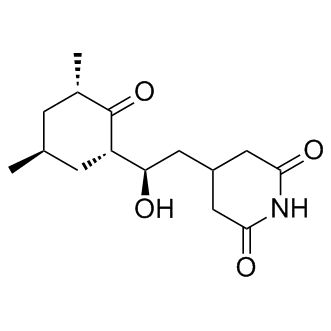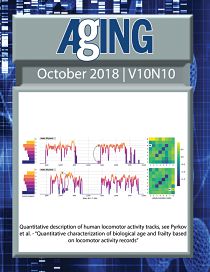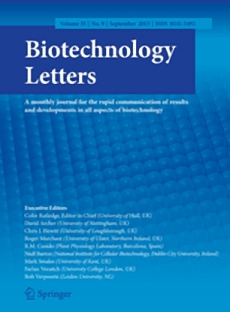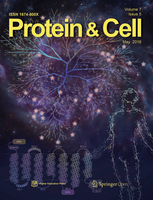All AbMole products are for research use only, cannot be used for human consumption.

Cycloheximide (Naramycin A) is an eukaryote protein synthesis inhibitor, with IC50 values of 532.5 nM and 2880 nM for protein synthesis and RNA synthesis in vivo, respectively. Cycloheximide is an inhibitor of protein biosynthesis in eukaryotic organisms, produced by the bacterium Streptomyces griseus. Cycloheximide exerts its effect by interfering with the translocation step in protein synthesis (movement of two tRNA molecules and mRNA in relation to the ribosome) thus blocking translational elongation. Cycloheximide is widely used in biomedical research to inhibit protein synthesis in eukaryotic cells studied in vitro (i.e. outside of organisms). It works rapidly. Its effects are rapidly reversed by simply removing it from the culture medium.

Cell Rep. 2025 Feb 19; .
HSPA8 dampens SCAP/INSIG split and SREBP activation by reducing PKR-mediated INSIG phosphorylation
Cycloheximide purchased from AbMole

Int Immunopharmacol. 2025 Jan 10;144:113564.
ITGB4/GNB5 axis promotes M2 macrophage reprogramming in NSCLC metastasis
Cycloheximide purchased from AbMole

J Virol. 2025 Jan 31;99(1):e0127724.
Swine RNF5 positively regulates the antiviral activity of IFITM1 by mediating the degradation of ABHD16A
Cycloheximide purchased from AbMole

Mol Cancer. 2024 Dec 19;23(1):274.
ZDHHC20 mediated S-palmitoylation of fatty acid synthase (FASN) promotes hepatocarcinogenesis
Cycloheximide purchased from AbMole

Adv Sci (Weinh). 2024 Jan;e2207435.
Defective Homologous Recombination Repair By Up-Regulating Lnc-HZ10/Ahr Loop in Human Trophoblast Cells Induced Miscarriage
Cycloheximide purchased from AbMole

Autophagy. 2024 Jun 6.
The novel lnc-HZ12 suppresses autophagy degradation of BBC3 by preventing its interactions with HSPA8 to induce trophoblast cell apoptosis
Cycloheximide purchased from AbMole

Brain. 2024 Jun 25.
Heterozygous variants in USP25 cause genetic generalized epilepsy
Cycloheximide purchased from AbMole

Environ Int. 2024 Sep;191:108975.
BaP/BPDE suppresses homologous recombination repair in human trophoblast cells to induce miscarriage: The roles of lnc-HZ08
Cycloheximide purchased from AbMole

Cancer Lett. 2024 Apr 6;590:216861.
TRAF6 enhances PD-L1 expression through YAP1-TFCP2 signaling in melanoma
Cycloheximide purchased from AbMole

Free Radic Biol Med. 2024 Aug 23;224:130-143.
Prohibitin 2 confers NADPH oxidase 1-mediated cytosolic oxidative signaling to promote gastric cancer progression by ERK activation
Cycloheximide purchased from AbMole

iScience. 2024 May 15.
Deficiency in Prader-Willi syndrome gene necdin leads to attenuated cardiac contractility
Cycloheximide purchased from AbMole

PLoS Pathog. 2024 Sep 30;20(9):e1012594.
TRIM56 restricts Coxsackievirus B infection by mediating the ubiquitination of viral RNA-dependent RNA polymerase 3D
Cycloheximide purchased from AbMole

J Biol Chem. 2024 Mar 25;300(5):107226.
Epstein-Barr virus suppresses N6-Methyladenosine modification of TLR9 to promote immune evasion
Cycloheximide purchased from AbMole

Cell Signal. 2024 May 26;111235.
BMSC derived EVs inhibit colorectal Cancer progression by transporting MAGI2-AS3 or something similar
Cycloheximide purchased from AbMole

Respir Res. 2024 Jul 25;25(1):287.
Novel hypoxia-induced HIF-1αactivation in asthma pathogenesis
Cycloheximide purchased from AbMole

Mol Carcinog. 2024 Jan.
SN-38, an active metabolite of irinotecan, inhibits transcription of nuclear factor erythroid 2-related factor 2 and enhances drug sensitivity of colorectal cancer cells
Cycloheximide purchased from AbMole

iScience. 2024 Jan 19.
FLOT2 promotes nasopharyngeal carcinoma progression through suppression of TGF-β pathway via facilitating CD109 expression
Cycloheximide purchased from AbMole

Mol Cell Biochem. 2024 Feb 17.
Tripartite-motif 3 represses ovarian cancer progression by downregulating lactate dehydrogenase A and inhibiting AKT signaling
Cycloheximide purchased from AbMole

Sci Rep. 2024 Oct 10;14(1):23685.
USP10 promotes cell proliferation, migration, and invasion in NSCLC through deubiquitination and stabilization of EIF4G1
Cycloheximide purchased from AbMole

Viruses. 2024 Sep 23;16(9):1503.
N-Acetylcysteine Inhibits Coxsackievirus B3 Replication by Downregulating Eukaryotic Translation Elongation Factor 1 Alpha 1
Cycloheximide purchased from AbMole

Leuk Res. 2024 Jun 29;52(1):46.
Combining the novel FLT3 and MERTK dual inhibitor MRX-2843 with venetoclax results in promising antileukemic activity against FLT3-ITD AML
Cycloheximide purchased from AbMole

Patent. CN117535410A 2024 Feb 09.
Patent. CN117535410A
Cycloheximide purchased from AbMole

J Transl Med. 2023 May 5;21(1):303.
SYTL2 promotes metastasis of prostate cancer cells by enhancing FSCN1-mediated pseudopodia formation and invasion
Cycloheximide purchased from AbMole

Cell Death Discov. 2023 Apr 26.
Ammonium Tetrathiomolybdate Relieves Oxidative Stress in Cisplatin-induced Acute Kidney Injury via NRF2 Signaling Pathway
Cycloheximide purchased from AbMole

Cell Death Discov. 2023 Jul 25;9(1):259.
Ammonium tetrathiomolybdate relieves oxidative stress in cisplatin-induced acute kidney injury via NRF2 signaling pathway
Cycloheximide purchased from AbMole

J Cell Mol Med. 2023 Aug 29.
Alleviation of temporomandibular joint osteoarthritis by targeting RIPK1-mediated inflammatory signalling
Cycloheximide purchased from AbMole

FASEB J. 2023 Oct;37(10):e23183.
IGF2BP2 promotes ovarian cancer growth and metastasis by upregulating CKAP2L protein expression in an m6A-dependent manner
Cycloheximide purchased from AbMole

New Journal of Chemistry. 2023 Jun 20.
Quantitative analysis of the effects of vimentin intermediate filaments on the early stages of influenza A virus infection
Cycloheximide purchased from AbMole

New J. Chem. 2023 Jun 28;47, 14344-14354.
Quantitative analysis of the effects of vimentin intermediate filaments on the early stages of influenza A virus infection
Cycloheximide purchased from AbMole

Biochem Genet. 2023 Nov 11.
Functional Characterization of a Novel SLC4A4 Variant and Uniparental Isodisomy in Proximal Renal Tubular Acidosis Patient
Cycloheximide purchased from AbMole

Cell Death Differ. 2022 Jul;29(7):1395-1408.
SARS-CoV-2 membrane protein causes the mitochondrial apoptosis and pulmonary edema via targeting BOK
Cycloheximide purchased from AbMole

Research Square. 2022 Oct 12.
IGF2BP2 promotes ovarian cancer growth and metastasis via upregulating CKAP2L protein expression in a m6A-dependent manner
Cycloheximide purchased from AbMole

Ecotoxicol Environ Saf. 2022 Jun 1;237:113564.
Environmental BPDE induced human trophoblast cell apoptosis by up-regulating lnc-HZ01/p53 positive feedback loop
Cycloheximide purchased from AbMole

Virol Sin. 2022 Aug 16;S1995-820X(22)00143-2.
CK1α upregulates the IFNAR1 expression to prompt the anti-HBV effect of type I IFN in hepatoma carcinoma cells
Cycloheximide purchased from AbMole

Cell Biol Toxicol. 2022 Apr;38(2):291-310.
Lnc-HZ08 regulates BPDE-induced trophoblast cell dysfunctions by promoting PI3K ubiquitin degradation and is associated with miscarriage
Cycloheximide purchased from AbMole

Bioengineered. 2022 Apr;13(4):8000-8012.
UBE2B promotes ovarian cancer growth via promoting RAD18 mediated ZMYM2 monoubiquitination and stabilization
Cycloheximide purchased from AbMole

J Biol Chem. 2022 Nov 21;102734.
Ubiquitin-specific peptidase 14 maintains estrogen receptor α stability via its deubiquitination activity in endometrial cancer
Cycloheximide purchased from AbMole

Mol Cell Endocrinol. 2022 Apr 5;545:111575.
An intron mutation of HNF1A causes abnormal splicing and impairs its activity as a transcription factor
Cycloheximide purchased from AbMole

Adv Sci (Weinh). 2021 Feb.
Inhibition Lysosomal Degradation of Clusterin by Protein Kinase D3 Promotes Triple‐Negative Breast Cancer Tumor Growth
Cycloheximide purchased from AbMole

Adv Sci (Weinh). 2021 Jan 6;8(4):2003205.
Inhibition Lysosomal Degradation of Clusterin by Protein Kinase D3 Promotes Triple-Negative Breast Cancer Tumor Growth
Cycloheximide purchased from AbMole

Clin Transl Med. 2021 Apr;11(4):e395.
FABP4 deactivates NF-κB-IL1α pathway by ubiquitinating ATPB in tumor-associated macrophages and promotes neuroblastoma progression
Cycloheximide purchased from AbMole

Int J Mol Sci. 2021 Aug 16;22(16):8779.
Autophagy Mediates the Degradation of Plant ESCRT Component FREE1 in Response to Iron Deficiency
Cycloheximide purchased from AbMole

J Cancer. 2021 Oct 17;12(23):7041-7051.
N6-methyladenosine regulates ATM expression and downstream signaling
Cycloheximide purchased from AbMole

Cell Rep. 2020 Jul 28;32(4):107974.
L ARP7 Is a BRCA1 Ubiquitinase Substrate and Regulates Genome Stability and Tumorigenesis
Cycloheximide purchased from AbMole

Cell Rep. 2020 Jul 28;32(4):107974.
LARP7 is a BRCA1 ubiquitinase substrate and regulates genome stability and tumorigenesis
Cycloheximide purchased from AbMole

Theranostics. 2020 Apr 27;10(13):5671-5686.
SUMO1 modification of methyltransferase-like 3 promotes tumor progression via regulating Snail mRNA homeostasis in hepatocellular carcinoma
Cycloheximide purchased from AbMole

Cell Oncol (Dordr). 2020 Oct 19.
Ubiquitin-specific protease 2a promotes hepatocellular carcinoma progression via deubiquitination and stabilization of RAB1A
Cycloheximide purchased from AbMole

Cell Microbiol. 2020 Mar;22(3):e13148.
Hepatitis B virus X protein modulates upregulation of DHX9 to promote viral DNA replication.
Cycloheximide purchased from AbMole

Life Sci. 2020 Sep 15;257:118021.
TRIB3 destabilizes tumor suppressor PPARα expression through ubiquitin-mediated proteasome degradation in acute myeloid leukemia
Cycloheximide purchased from AbMole

Front Cell Infect Microbiol. 2020 Apr 16;10:158.
Difluoromethylornithine, a Decarboxylase 1 Inhibitor, Suppresses Hepatitis B Virus Replication by Reducing HBc Protein Levels
Cycloheximide purchased from AbMole

Aging (Albany NY). 2018 Oct 18;10(10):2783-2799.
Ubiquitin-specific protease 4 promotes metastasis of hepatocellular carcinoma by increasing TGF-β signaling-induced epithelial-mesenchymal transition.
Cycloheximide purchased from AbMole

Biotechnol Lett. 2018 Aug;40:1181-1188.
UHRF2 promotes DNA damage response by decreasing p21 via RING finger domain.
Cycloheximide purchased from AbMole

Protein Cell. 2017 Mar;8(3):202-218.
E3 ligase UHRF2 stabilizes the acetyltransferase TIP60 and regulates H3K9ac and H3K14ac via RING finger domain
Cycloheximide purchased from AbMole
| Molecular Weight | 281.35 |
| Formula | C15H23NO4 |
| CAS Number | 66-81-9 |
| Solubility (25°C) | DMSO ≥ 80 mg/mL Water 15 mg/mL (ultrasonic and warming) |
| Storage | 4°C, protect from light |
| Related DNA/RNA Synthesis Products |
|---|
| Deoxyribonucleic Acid (from Salmon sperm)
Deoxyribonucleic Acid (from Salmon sperm) can be used as a research reagent, widely used in molecular biology, pharmacology and other scientific research. |
| GSK4418959
GSK4418959 (IDE275) is a non-covalent, reversible, selective and orally active WRN helicase inhibitor. GSK4418959 inhibits ATPase and DNA unwinding functions in an ATP-competitive manner. |
| Dencatistat
Dencatistat (P115) is an inhibitor of Cytidine Triphosphate Synthase 1 (CTPS1) with an IC50 value of ≤ 0.1 μM. |
| Antipain dihydrochloride
Antipain dihydrochloride is a protease inhibitor. Antipain dihydrochloride inhibits N-methyl-N'-nitro-N-nitrosoguanidine (MNNG)-induced transformation and increases chromosomal aberrations. Antipain dihydrochloride also restricts uterine DNA synthesis and function in mice. |
| Tetrahydrouridine
Tetrahydrouridine (THU) is potent inhibitor of cytidine deaminase (CDA), which competitively blocks the enzyme's active site more effectively than intrinsic cytidine. |
All AbMole products are for research use only, cannot be used for human consumption or veterinary use. We do not provide products or services to individuals. Please comply with the intended use and do not use AbMole products for any other purpose.


Products are for research use only. Not for human use. We do not sell to patients.
© Copyright 2010-2024 AbMole BioScience. All Rights Reserved.
